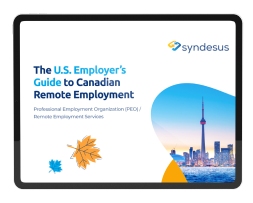In recent years, the Canadian government has been making significant progress in technology and is investing billions of dollars into areas such as quantum computing and artificial intelligence, as well as supporting the development of tech hubs across the country.
Canada is producing world-class technology firms and drawing the attention of major global tech giants such as Amazon and Google.
But Canada has also invested significantly in the most important technology resource: people. Canada is a tech haven with a vibrant, expanding, and diversified technical workforce that must be maintained for Canada’s economy to flourish.
Many tech workers from around the world, including the US, have moved to Canada recently, and even more, workers are currently considering Canada an attractive option.
From workers with dual American/Canadian citizenship who want to keep their US jobs while living in Canada to H-1B tech workers who are seeking a clearer immigration pathway that will lead to permanent residence, Canada is becoming the #1 destination for tech.
But despite Canada’s obvious perks, tech workers still have questions: What is it like working in the Canadian tech sector? How easy is it to immigrate to Canada? And what is life like in Canada?
This article will explore these questions.
Canada’s tech sector is thriving and continues to grow
Canada’s tech sector is booming, in part thanks to a large and diverse talent pool, and investment in research and businesses from all levels of the Canadian government.
The Canadian government has made several significant investments to position Canada as a global leader in quantum research and development.
Quantum computers are capable of solving complex problems far more quickly and efficiently than traditional computers.
Potential commercial applications for quantum computers include healthcare, finance, materials design, defense, and clean technologies.
Canada has a well-developed national quantum technology initiative, with $23 billion in funding as of January 2022.
It expects quantum technology will become an $86 billion industry by 2040 and will reap big benefits from the emerging field.
Tech sector growth has resulted in numerous tech hubs cropping up across Canada.
According to a study by the National Research Council of Canada (NRC), the overall economic impact of quantum technologies in Canada is expected to reach $533 million with 1,100 positions by 2025.
The government isn’t the tech sector’s only investor either. Record-breaking amounts of capital have been pouring into Canada’s start-up ecosystem in recent years.
According to the Canadian Venture Capital and Private Equity Association, Canada has witnessed a record-breaking number of venture capital deals in 2021, with over $15 billion invested into more than 753 companies, which is roughly double the 2019 record of $6.2 billion.
Artificial intelligence is also a major topic of interest for many Canadian venture capitalists, and Canada is already proving itself a global leader in the field.
The clean energy and environmental sustainability industries are another area of interest for investors, especially those on the West Coast of Canada.
Tech sector growth has resulted in numerous tech hubs cropping up across Canada.
Toronto has evolved into North America’s third-largest technology cluster due to years of investment by local institutions, government agencies, and Canada’s flexible and responsive immigration policies.
Local institutions in and around Toronto are working hard to nourish the tech industry, including two universities.
A high-tech innovation center endowed with $100 million in local corporate cash will be built by the University of Toronto, and Ontario’s University of Waterloo was recently recognized as one of the world’s top ten institutions.
A second Canadian technology center can be found in Nova Scotia.
The growing information technology sector in Halifax is fast transforming Nova Scotia into one of Canada’s most dynamic technology hotspots. Nova Scotia’s economy is gaining momentum as a result of an expanding ecosystem of companies, venture capital, and government assistance.
According to global real estate firm CBRE, the number of technology specialists in Halifax has increased by 24% in the last five years.
Nova Scotia’s $2.5 billion technology sector now has over 26,000 workers and the Nova Scotia government handed out $16.8 million in funding to four local schools to develop computer science programs.
This is yet another signal that the technology industry in this province — and throughout Canada — will continue to grow!
The quality of life in Canada is high and the cost of living is low
As you can see, moving to Canada can advance your tech career, but it’s also an all-around great place to live and often tops global quality of life rankings. It’s also worth noting that Canada’s reputation as a kind and open nation is completely deserved.
Canada has set a target of adding 400,000 immigrants each year to increase its current 38 million population, and the goal of the Century Initiative is to increase Canada’s population to 100 million, particularly through immigration.
Immigrants already make up one-fifth of Canada’s population, and if current trends persist, half of the country’s population will be foreign-born or have at least one immigrant parent in 2036.
In addition to being friendly, Canada is also slightly more affordable than its neighbor to the south.
Healthcare in Canada is paid for through taxes, and Canadian citizens or permanent residents are not required to pay for most healthcare services.
Canada’s cost of living is just a little lower than that of the United States, and its average income is comparable as well, but it provides greater social benefits.
The most expensive Canadian universities are about 16% to 38% less costly than private universities in the United States.
Given that medical expenses are the most common source of debt for Americans, (18% of Americans have medical debt, and collection agencies held $140 billion in unpaid medical bills last year!), it’s important to point out the benefits of Canada’s universal healthcare system.
Healthcare in Canada is paid for through taxes, and Canadian citizens or permanent residents are not required to pay for most healthcare services.
Healthcare costs in Canada are significantly lower than those in the United States: $7,068 per Canadian annually on average, compared to approximately $10,739 for a typical American.
To top this all off, Canada has an endless variety of landscapes. Spread across six time zones you’ll find mountains, glaciers, remote beaches, and even rainforests.
The terrain makes for a fantastic playground for snowboarding, surfing Nova Scotia’s swells, or hiking seemingly endless mountains.
Canada’s welcoming attitude comes complete with straightforward immigration pathways for interested tech workers.
What is Canadian immigration like for tech workers?
If you’re searching for a fresh job in Canada, the Global Talent Stream (GTS) is the greatest way to go. The goal of Canada’s GTS was to attract highly skilled workers and empower Canadian businesses to hire foreign specialists.
…the Global Talent Stream is a popular immigration pathway because its expedited processing means that you can have a work permit in less than two weeks
Through GTS, you can get authorization to work in Canada within two weeks, which is without a doubt Canada’s quickest immigration path for employees.
To be eligible, you must have a work offer from a Canadian employer that is looking for individuals with specialized or in-demand occupations on the Global Talent Occupations List.
Despite these restrictions, the Global Talent Stream is a popular immigration pathway because its expedited processing means that you can have a work permit in less than two weeks.
Better still, the program is an excellent pathway to permanent immigration to Canada.
Another popular pathway to Canada is the Provincial Nominee Programs (PNP). Eleven of Canada’s provinces and territories have established their own immigration systems to attract people with particular talents.
Each PNP is tailored to speed up immigration processing, filling shortages in the job market.
The first step is to submit an application for a PNP, which must be approved by a province in anything from two weeks to nine months of processing time.
Once you’ve been accepted — or nominated — your application must receive federal approval, which can take up to six months.
Recently, a newly proposed visa pathway has gained traction: The High Potential Tech Visa.
The Council of Canadian Innovators (CCI) is urging the federal government to establish a High Potential Tech Visa for in-demand tech professionals.
The proposed visa would provide high-skilled, tech graduates with an alternative pathway to permanent residency in Canada without a job offer in hand.
Currently, Canada’s immigration system requires most individuals applying for work visas to have a valid employment offer.
Some believe this to be an undue impediment for highly skilled tech workers who wish to establish a career and life in Canada.
The proposed visa path would provide flexibility to potential workers by allowing them to work, change jobs, or move employers.
For the time being, this visa is only a proposal, but it demonstrates how Canada’s technology sector is continuing to develop and how keen the nation is to welcome new talent.
American tech companies and workers alike are heading north to Canada to bask in its booming tech scene and welcoming immigration policies.
The Global Talent Stream and Provincial Nominee Programs are the two most popular ways to find work in Canada, but maybe you already have a US tech job you love — what can you do?
Syndesus can help you keep your US job while moving to Canada
It’s possible to keep your US job and work remotely in Canada with a little help from a Canadian PEO. A Professional Employer Organization — commonly referred to as a PEO — enables a US-based company to remotely hire workers in Canada without needing to have an office there.
Imagine this: An American tech worker with a job at an American company wants to move to Canada but keep their current position.
The job will feel like any other remote work, but it’s essentially as if the US company had an office in Canada.
A Canadian PEO — like Syndesus — can be the legal employer of this American tech employee.
The PEO would have the worker on their Canadian payroll and handle all the technical aspects of employment such as issuing paychecks and managing employee benefits.
But here’s the twist — the original US tech company would still be in 100% control of the job, would be the one paying the salary, can offer stock options, and more.
The job will feel like any other remote work, but it’s essentially as if the US company had an office in Canada.
So you get to keep your American job, but get all the perks of living in Canada.
Whether you want to take your American job to Canada or start fresh with a new tech job, you have plenty of pathways for Canadian immigration.
Want a new job in Canada? Path to Canada helps foreign-born tech workers explore Canadian jobs and connects them with Canadian tech companies willing to sponsor them.
We also help Canadian tech companies find experienced technical talent who are seeking to move permanently to Canada.
We pre-qualify applicants so you only interview the very best global talent.
Are you looking for a tech job in Canada or are you a Canadian company seeking qualified candidates?
Visit our website to learn more about how we can help you, or join our database of qualified candidates seeking to move to Canada!




